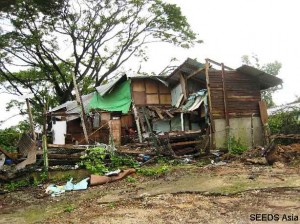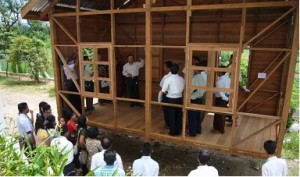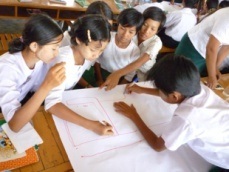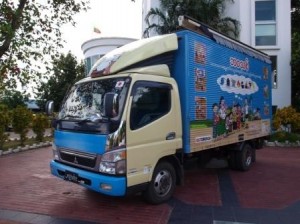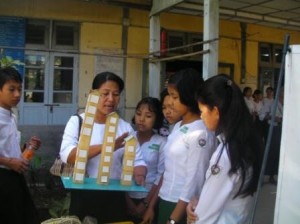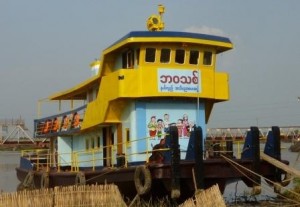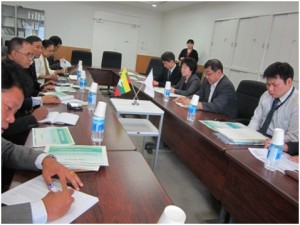Project Overview
Background
Myanmar has approx. 2,000km coastline, and is prone to natural disasters such as tsunamis, storm surges, and floods, as well as cyclones and earthquakes, since it is on active faults. In addition, it has suffered landslides and tornadoes in recent years, reportedly due to deforestation or climate change.
In particular, the Cyclone Nargis of 2008, with wind speed of 250kph, caused massive storm surge, left more than 140,000 deaths and missing.
Reconstruction from disasters require the viewpoint of “build back better” in order to minimize possible damages from similar disasters in the future.
Since 2008, SEEDS Asia has set up the office in Yangon and contributed to the reconstruction from the Cyclone Nargis by conducting activities on DRR skills transfer or DRR education.
Activities in Myanmar
Technical assistance for construction of temporary housings
Rebuilding houses was imminent after the Cyclone Nargis. For building resilient houses against disasters, technical assistance was demanded at the time of temporary housings construction. The first project for the victims of the cyclone was “Technical assistance for temporary housings construction and capacity building for victims of the Cyclone Nargis” implemented from August to September 2008. A workshop on Disaster Risk Reduction (DRR) policies for senior government officials, local officials, and company executives was conducted, as well as the one for improvement of construction skills and knowledge for local carpenters or employees of construction companies. At those workshops, various activities were conducted by SEEDS Asia staff members, including Japanese DRR policies introduction and safer building training.
School DRR project
The next activity was securing safety at schools, where children gather and also are used as shelters. After the needs survey on DRR education, school DRR project was started in the delta region, Labutta and Dala in Ayeyarwady region. Specifically, discussions and workshops on DRR were conducted by teachers and students of the target elementary schools, in order to confirm safe or dangerous places in the towns. Also, upon their requests, the school buildings and commuting streets partially broken were fixed by SEEDS Asia for securing safety in the event of disasters.
Mobile Knowledge Resource Center (MKRC)
Although DRR education was not carried out sufficiently even at schools in the cities, the situation was worse at schools in farming or fishing villages, far from the cities without access to such information or assistances. Thus, Mobile Knowledge Resource Center (MKRC), customized-truck, was developed by SEEDS Asia and Myanmar Engineering Society (MES), the group of local engineers in 2009.
MKRC is the customized-truck as participatory DRR learning facility with DRR models, posters, and card games for children to learn DRR with fun by looking or touching them.
Training of Trainers (ToT) is one of the specialties of MKRC training. ToT is a type of training that teachers receive DRR training first, and then students and community people get the training by those teachers. Through the process, DRR education skills are learnt by the teachers, as well as DRR knowledge are obtained by other teachers, students, and community people.
KIDA (knowledge-Interest-Desire-Action) model*, knowledge management model, is used in a training program to effectively raise interest in DRR and put it into practice. In particular, the program consists of the following: making teaching materials as posters, card games, and models to learn mechanism of disasters and methods of securing safety; making life-saving device made of plastic-bottles and hazard maps; setting up a school DRR task-force committee; and practical workshops including DRR activity plan making or evacuation routes confirmation. Also, MKRC has been highly evaluated by the participants for providing DRR knowledge in an enjoyable format with games and practice using characters from a popular local cartoon for exterior of the MKRC truck and in the teaching materials, while resolving lack of transportation and time for people in the remote areas by using the truck as mobile resource center.
*KIDA model: KIDA was developed based on the AIDMA model (Attention-Interest-Desire-Memory-Action) used in the field of advertising to consider the process from consumer giving attention to products to buying them. KIDA is knowledge, interest, desire, and action. Knowledge, interest, and desire are necessary to promote to take action and actions are significant outputs of disaster education. (Rajib Shaw, “1-2-3 of Disaster Education,” Kyoto University (2010))
Water Knowledge Resource Center (WKRC)
Water Knowledge Resource Center (WKRC) was developed, in order to reach to the remote areas in delta region, where are not accessible by cars from the capital city of Yangon. Some of the areas were devastated by the Cyclone Nargis, and have high demand of DRR education.
WKRC has been going in the rivers and ocean to deliver DRR knowledge to children in those areas.
Capacity Building of Government Officials and Engineers engaging in DRR
After the Cyclone Nargis, Myanmar government has been promoting the national disaster countermeasures. In 2010, DRR component was incorporated into the subject of Life Skill. In 2012, under the new government, a national disaster countermeasure, Myanmar Action Plan for Disaster Risk Reduction (MAPDRR) was officially issued.
As mentioned above, the system to promote DRR activities in the field of DRR education or politics has just established in Myanmar. In order to carry out quality DRR activities, guidance/supervision by officials/engineers with DRR expertise is needed, to evaluate properly and improve DRR activities. Also, for sustainability, building networks between the government officials and local engineers are significant.
Therefore, SEEDS Asia has been assisting capacity building of government officials and engineers in the DRR field and building networks between them, in cooperation with MES, a group of local engineers. With support of relevant ministries, organizations, and academic institutions, since 2011, DRR training has been conducted in Japan for Myanmar government officials. In addition, inviting Japanese experts to Myanmar, symposiums and workshops have been held to share Japan’s DRR knowledge, experiences, and lessons for Myanmar government officials and DRR working group (consists of UN/International NGOs staff members).
DRR learning center jointly run by schools and communities
After the Cyclone Nargis, DRR education was incorporated into school curriculum as part of Life Skill in 2010. As most of the delta region was covered by WKRC and MKRC, building a DRR learning center would be the next step for sustainability. The center would be run jointly by schools and communities for DRR activities would enable capacity building of persons who will lead the sustainable society and education for sustainable development (ESD).
SEEDS Asia will start making a model of DRR learning center to enhance DRR capacity at schools and communities in Myanmar.
About Myanmar
Official name: Republic of the Union of Myanmar
Location: Western part of Indochina Peninsula bordered by China, Thailand, India, Laos and Bangladesh
Capital: Nay Pyi Taw (formerly Yangon)
Ethnic groups: Burman 60%, and other minority ethnic groups
Area: 676,578 km2 (1.8 times bigger than Japan)
Population: 60,620,000 (as of 2012, source: Asian Development Bank (ADB), slightly less than half of Japan population
After nationwide pro-democracy demonstrations in 1988 led to collapse of the socialist regime, the national military quelled the demonstrations and came to power. Since then, military regime has been continued; however, pro-democracy movement has become active recently, and accelerated after formation of the new government under the President Thein Sein in March 2011: In August 2011, direct-dialogue was held between pro-democracy leader Aung San Suu Kyi and President Thein Sein; In October 2011, more than 200 political prisoners were released; In November 2011, the National League for Democracy led by Aung San Suu Kyi decided to be registered as political party and to participate in by-election.
Due to the economic sanction by U.S. and EU, economic base was weak; for instance, lack of basic and financial infrastructures, multiple exchange rate system. However, after the economic sanction was eased in 2012, companies from all over the world have started their businesses. Myanmar’s economic growth rate and inflation rate are estimated to be 5.5% (2011, IMF estimate) and 6.6% (2011, IMF estimate), respectively. At the moment, Myanmar is going through the active reforms and economic growth.
* This article is written on the basis of articles on the website of Ministry of Foreign Affair of Japan at http://www.mofa.go.jp/region/asia-paci/myanmar/data.html (in Japanese)
